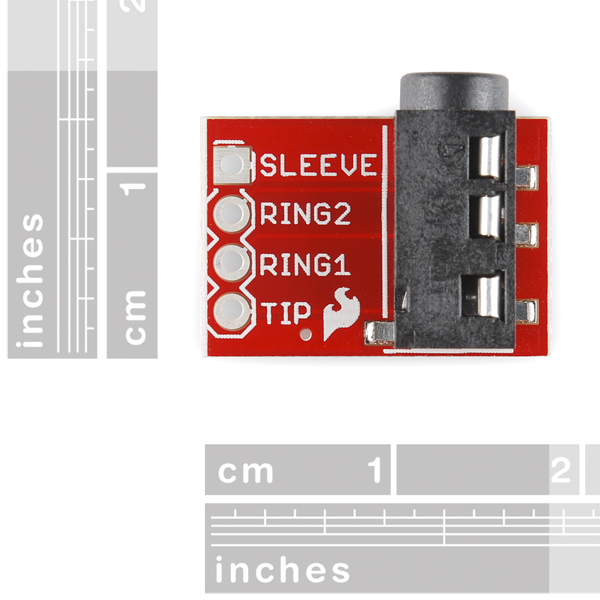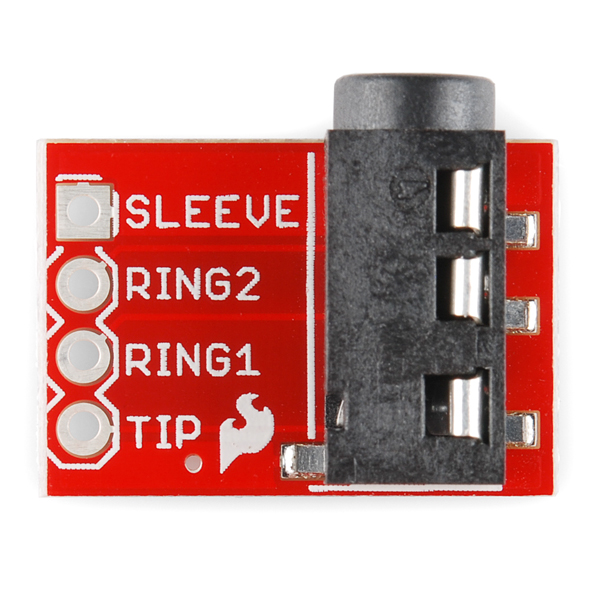SparkFun TRRS 3.5mm Jack Breakout
TRRS connectors are the audio-style connectors that you see on some phones, MP3 players and development boards. TRRS stands for "Tip, Ring, Ring, Sleeve," which reflects the fact that, unlike a standard stereo connector, this actually has three conductors and a ground. Some devices use the extra conductor for a microphone (like hands-free headsets) or to carry a video signal (like in some MP3/MP4 players). This breakout board makes it easy to add a TRRS jack to your prototype or project by breaking out each conductor to a standard 0.1" spaced header.
SparkFun TRRS 3.5mm Jack Breakout Product Help and Resources
Connector Basics
January 18, 2013
Connectors are a major source of confusion for people just beginning electronics. The number of different options, terms, and names of connectors can make selecting one, or finding the one you need, daunting. This article will help you get a jump on the world of connectors.
Environmental Monitoring with the Tessel 2
October 13, 2016
Build an air-conditioner monitoring device to collect environment information and store it in the cloud.
Noisy Cricket Stereo Amplifier - 1.5W Hookup Guide
April 26, 2018
A hookup guide for the Noisy Cricket Stereo Amplifier - 1.5W.
Core Skill: Soldering
This skill defines how difficult the soldering is on a particular product. It might be a couple simple solder joints, or require special reflow tools.
Skill Level: Noob - Some basic soldering is required, but it is limited to a just a few pins, basic through-hole soldering, and couple (if any) polarized components. A basic soldering iron is all you should need.
See all skill levels
Comments
Looking for answers to technical questions?
We welcome your comments and suggestions below. However, if you are looking for solutions to technical questions please see our Technical Assistance page.
Customer Reviews
4.7 out of 5
Based on 6 ratings:
1 of 1 found this helpful:
Good product
Works great as expected
As expected
Nice little unit! I soldered it into place without incident. Maybe I'll get to plug the earbuds into it and detect nuclear decay from my newly built bGeigie Nano Geiger counter.
Works perfectly!
This is exactly what I needed and works great! I'm glad that it is a 4 pin connector so I can fully use my headset!
So far so good
This is the only 4 pin 3.5mm headphone jack breakout we could find anywhere online and its working great.
Simple, effective and high quality
ordered them for final prototyping before soldering direct... this is a pretty basic product, well made and worked flawlessly. not much to say other than it's a high quality jack (nice tight pressure in the jack) and breakout board.
If you are using with RasPI and GPIO you need to pay attention exactly how you plan your connections.... Not putting your connections in the right order, based on your pin out plan can be the different between being able to Hot Swap 1Wire sensors and causing a reboot due to shorting the pins as you plug it in......





Just in case someone else is needing to interface to "standard" earbud/microphone sets, I'll share what I tracked down in the way of specs: from the plug (earbuds) side and from the jack (phone) side.
Great, any reason you are not selling the connector without the breakout board ?
Thanks
Screw holes? Where are the screw holes!?! Gah! The lack of screw holes makes it so much harder to use these things in projects (well, my kind of projects). Please please please add screw holes to any breakout...please!
I agree that this is useless without mounting holes.
ever heard of adhesives? they work quite well! But they aren't so good for temporary uses....
they are meant to go in a breadboard for prototyping.
Will this work with a Tip and Sleeve plug?
The connector only is PRT-12639
This connector would be great where space is at a premium. Would like to buy some of these w/o breakout. How about it?
How do I hook this up to an arduino for FFT and spectrum analysis
Answering this for people who are looking :P
Arduino FHT can provide you a quick solution for frequency analysis: http://wiki.openmusiclabs.com/wiki/ArduinoFHT
What is the part number for the connector on this board? I'd like to find out more information on it. Is a datasheet available?
Hello? Anybody?
We put up datasheets if we have them. What in particular do you want to know?
"What is the part number for the connector on this board?"
"Is a datasheet avaiable?"
Thanks...
I did some research for you, this one should be equivalent.
Ah great! Thank you.
With a vast supply of cheep ipod shuffle cables out there this would be a slightly noisier but more robust usb connector for a project.
It's not quite clear in the photo if the center of the headers are hollow or if they are metal contacts. Can someone please clear this up for me. Thanks!
they are holes.
This is an awesome board, now i just need to makeup a project around it xD